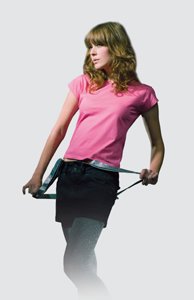
Jerzees is a large promotional clothing brand with a higher profile in the USA than in the UK. It's American website is in fact curiously unhelpful to our quest for information on the brands ethical credentials. However Jerzees is one of the brands of the Russell Corporation (Russell itself being the other well known brand) and its European website
is much more helpful as well as being rather more attractive.
Unlike the Jerzees USA website, there is a page devoted to "Our Ethics". "Russell Europe believes worldwide ethical practices and principles are now more important than ever. We work to a strict code of practice to help ensure none of our manufacturing processes put the environment at risk. Equally vital is the welfare of the people who make our garments, wherever they are in the globe."
All the Jerzees garments are Öko-Tex certified (which means no harmful residual chemicals may be in place in the clothing after manufacture and that the environmental impact of the production process itself was minimal). They also say that they are "committed to having all our manufacturers WRAP (Worldwide Responsible Apparel Production) accredited".
Now it's obvious that this means that Jerzees suppliers are not all currently WRAP accredited. I visited the WRAP website to see if that might shed some light. Unfortunately because Jerzees outsources its production and their site does not say where, and WRAP monitors the actual factories not brands, the WRAP organisation is not going to be able to help us.
The Russell Corporation itself was recently acquired by Berkshire Hathaway Inc., which owns Fruit of the Loom. The link is to our separate blog article on Fruit of the Loom where we considered the status of Berkshire Hathaway as the owner of that brand. In that article I mentioned 'high minded ideals' so in that respect the intention of Jerzees to have all its suppliers WRAP certified is good and in keeping with its owner's ideals.
But we'd really like to have more concrete information on how much of Jerzees production is currently WRAP certified and how long it will be before it all is certified. And what is the status of its other suppliers - what standards are applied there?
As ever help on this sort of issue is appreciated from anyone who can shed light on the answers.
